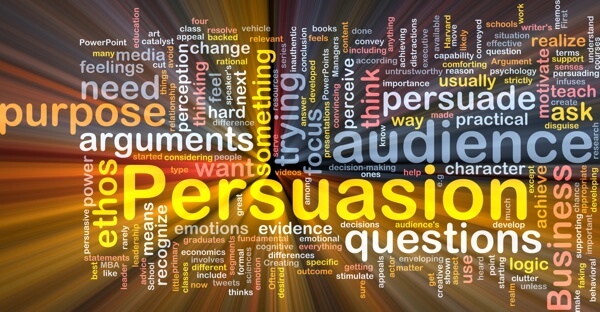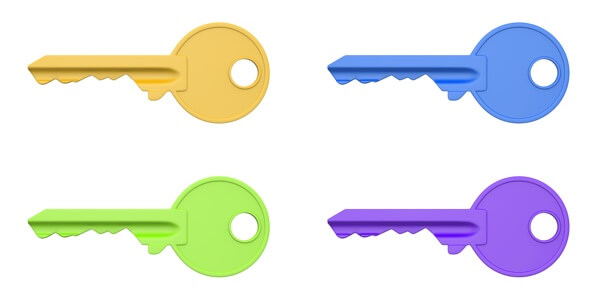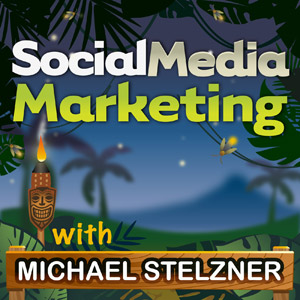 Do you want to persuade more people to become customers?
Do you want to persuade more people to become customers?
Wondering what the latest science on influence and persuasion has to say?
To discover new ways to prepare people for a sale, I interview Dr. Robert Cialdini, author of Influence and Pre-Suasion.
More About This Show
The Social Media Marketing podcast is an on-demand talk radio show from Social Media Examiner. It's designed to help busy marketers and business owners discover what works with social media marketing.
In this episode, I interview Robert Cialdini, author of Influence and CEO of Influence at Work, a company that provides speakers and training on behavioral psychology and influence in business. Having sold more than 3 million books, he helped coin marketing phrases such as “social proof” and “scarcity.” His latest book is called Pre-Suasion: A Revolutionary Way to Influence and Persuade.
Robert explores the science behind influence and persuasion.
You'll discover how to put these concepts into action to benefit your business.

Share your feedback, read the show notes, and get the links mentioned in this episode below.
Listen Now
Where to subscribe: Apple Podcasts | Spotify | YouTube Music | YouTube | Amazon Music | RSS
Here are some of the things you'll discover in this show:
Influence and Persuasion
Robert's First Book
Influence, written in the mid-1980s, shares the most successful strategies that professional influencers use to get people to say yes. It was written for consumers so they could recognize and resist these strategies when used in an unwelcome way.

The initial response to the book was so mild that the publisher called back the promotional and publicity funds for promoting the book, Robert recalls. They told him it would be like “throwing money down a pit.”
What happened to change things?
Get World-Class Marketing Training — All Year Long!
Are you facing doubt, uncertainty, or overwhelm? The Social Media Marketing Society can help.
Each month, you’ll receive training from trusted marketing experts, covering everything from AI to organic social marketing. When you join, you’ll also get immediate access to:
- A library of 100+ marketing trainings
- A community of like-minded marketers
- Monthly online community meetups
- Relevant news and trends updates
Robert explains that times changed. The idea of evidence-based decision-making began to dominate the business world, and Influence provided a compendium of evidence on what factors influence people. About three or four years after publication, the book skyrocketed to bestseller levels, where it's stayed ever since.
There were two sources of information for the book. To see what was especially successful in moving people toward a sale, he looked at research literature from the behavioral sciences, marketing, psychology, communication, management, and other fields.
He also looked beyond the research literature and began infiltrating all of the training programs he could get access to in the areas of sales, marketing, recruiting, fundraising, etc. This let him see what the professionals were using to train and he gleaned information from those experiences.
While he expected consumers to be the audience for Influence, it was actually embraced by the business community first. They wanted to know, scientifically, which factors incline people toward yes, and how to include those factors in messages, marketing campaigns, and more.
The interest in harnessing the most powerful practices and procedures for creating change led Robert to write his new book, Pre-Suasion. It's designed for people who want to become more influential.
Listen to the show to discover how I was introduced to Robert's work.
Pre-Suasion
Robert thinks the ideal audience for Pre-Suasion is people who want to increase the extent to which their messages successfully move people in their direction. While this includes salespeople and marketers, it's also for people who want to be more influential inside their families, network of friends, charity boards, etc.

Robert says that while Influence covers what to build into a message to get agreement, Pre-Suasion describes the process of gaining agreement with a message before it's sent. The process may seem like some sort of magic, but it's not. It's established science.
The key is to create a state of mind in the recipient's head that's consistent with the forthcoming message. This step is crucial for maximizing desired change.
For example, Robert explains how in one study, researchers approached individuals and asked for help with a marketing survey. Only 29% agreed to participate.
When researchers approached the second sample and preceded their request with a simple pre-suasive question, “Do you consider yourself a helpful person?”, 77.3% volunteered to participate in the survey.
Why do you think that is?
Robert says that when asked before the request if they were helpful, nearly everyone said yes. So when the request for help occurred, most agreed to participate to be consistent with the recently activated idea of themselves as helpful people.
It's a two-step process involving reverse engineering the typical strategy or sequence of persuasion.
First, decide what your major strength is: identify the greatest benefit to someone choosing what you have to offer. Is it reliability, durability, cost, or quality? Second, to attune people to the message that's about to come to them, go to the moment before the message is delivered and present an idea or an image consistent with that strength.
To illustrate this point, Robert talks about an experiment conducted by an online furniture store, which offered high-quality comfortable furniture, as well as lower-end inexpensive furniture.
They sent half of their visitors to a landing page with a depiction of fluffy clouds in the background. Why? Clouds are associated with comfort. The visitors who saw that landing page rated comfort as the most important factor for choosing furniture. They searched the site for features related to comfort and preferred to make a purchase based on the comfort of the furniture involved.

The second half of visitors were sent to a landing page that had coins as its background. They rated cost as the most important feature in purchasing furniture and searched for price-related information, and thus preferred to purchase inexpensive furniture.
Essentially, the marketers were able to create a comfort-oriented buyer or a price-oriented buyer based on what buyers were presented with immediately before they made a qualifying choice. That's the reverse engineering aspect of this, Robert explains. You know the solution. Your task is to put people in a state of mind that attracts them to it.
Robert notes that pre-suasion can be accomplished regardless of the medium you use. Whatever you do to draw people's attention to a particular concept makes them see that concept as more important than they did immediately before their attention was drawn to it. It's what causes them to search for the subsequent information in a particular way.
In the furniture study, when people's attention was drawn to clouds, comfort became important. When their attention was drawn to money, price became important. When they were asked afterward if the clouds or the coins made any difference in their choice, not one of them thought it had.
Listen to the show to hear why Robert believes only some advertisers know about this concept.
How to Identify Strengths
Robert says many organizations and marketers fail to fully understand their strengths. They need to know what ‘thing' they offer makes it wise for people to choose them. Ask yourself what you have to offer that makes it wise for people to choose you.

Discover Proven Marketing Strategies and Tips
Want to go even deeper with your marketing? Check out the Social Media Marketing Podcast! Publishing weekly since 2012, the Social Media Marketing Podcast helps you navigate the constantly changing marketing jungle, with expert interviews from marketing pros.
But don’t let the name fool you. This show is about a lot more than just social media marketing. With over 600 episodes and millions of downloads each year, this show has been a trusted source for marketers for well over a decade.
Instead of the thing that gives you the biggest profit margin or what makes it easy for you to distribute, think about your safety, reliability, durability, novelty. That's what leads people to make choices that are in their best interests, not just yours. Steer people in the direction of good choices and they'll register that offering as something that will benefit them.
After reading Pre-suasion, a man messaged Robert saying the book caused him to change something. He had a remarkable result. The man's sons sold popcorn outside of grocery stores to get funds for the Boy Scouts. As people exited, the boys asked if they wanted some. The majority shook their heads and walked on by. They just left the grocery store. If they wanted popcorn, they could have gotten it inside.
After the man read what Robert said about identifying your strengths, he changed the question to, “Do you support the Boy Scouts?” Now people said yes. They would come over to buy popcorn or at least make a donation. The man discovered the key to the message wasn't popcorn. They weren't selling popcorn. They were selling the Boy Scouts.

This tactic can also be used in written communication. The key is to find the place for executing the tactic. For example, when you send an email with the message and attachment, put a quote or slogan at the bottom of the email related to the topic.
For instance, if you want people to be open to change, put a quote at the bottom of the email associated with the reason for opening up to change. Robert likes this one by British author L.P. Hartley: “The past is a foreign country. They do things differently there.”
Listen to the show to hear my example of a quote and related topic.
Ethical Considerations
It took Robert about three years to craft Pre-Suasion. As he did for Influence, Robert looked at the literature in behavioral science and sampled from it. However, instead of infiltrating training programs of influence professionals, Robert went back to his notes to see what the highest scorers in each profession were doing.
He found that the aces of sales, marketing, advertising, recruiting, and fundraising pre-suade their audiences. These pros act like expert gardeners. They recognize that it doesn't matter how good the seed is if you haven't prepared the soil. Successful people spend their time thinking about and organizing the moment before the message, as well as the message itself.
Robert shares a story from one of his training experiences. They were doing home sales for an expensive heat-activated fire alarm system, and the best salesperson, Jim, had a remarkable approach.

Jim started by giving people a 10-minute test on fire safety knowledge. Then while they were in the middle of the test, he would slap his forehead and say, “Oh, I forgot some important materials out in the car. Would you mind if I let myself out of and back into your home? I don't want to interrupt your test.” People would often give Jim a key so he could leave and come back in on his own. When he returned, he would begin the sales pitch.
When Robert asked him about it, Jim said, “Whom do you allow into and out of your house at will by giving them a key? Only someone you trust, right?”
Jim used this tactic to establish trust in the minds of those buyers before he began his messaging. He pre-suaded them to see him as a trustworthy source of information before he began sending that information to them. Jim was always the top salesperson by a huge margin.
Listen to the show to hear my thoughts about the ethical side of using this concept.
Discovery of the Week
There are a lot of tools available, such as Calendly and ScheduleOnce, that remove the hassle of scheduling appointments.
Assistant.to is a native Gmail plugin that has access to your Google calendar. Simply press a button inside your Gmail to offer up a few available times, and they get populated into the email you're writing.

To set up an appointment through Assistant.to, you need to use the desktop version of Gmail.
First, put the other person's email address in the To section. Then in the email, you'll see a little “A.” Click that to bring up your calendar and see availability. Select a few different time chunks that you want to offer as options. Then click Add and it pastes them into the body of the email.
All of the times are clickable. After the receiver selects an available time, the system confirms it and then adds the appointment to both calendars.
Check out Assistant.to. It's free.
Listen to the show to learn more and let us know how Assistant.to works for you.
Listen to the show!
Key takeaways mentioned in this episode:
-
- Learn more about Robert on his website.
- Read Influence and Pre-Suasion: A Revolutionary Way to Influence and Persuade.
- Learn more about British author L.P. Hartley.
- Take a look at Calendly and ScheduleOnce.
- Check out Assistant.to.
- Watch our weekly Social Media Marketing Talk Show on Fridays at 8 AM Pacific on Huzza.io, or tune in on Facebook Live.
-
- Learn more about Social Media Marketing World 2017.
- Download the 2016 Social Media Marketing Industry Report.
Help Us Spread the Word!
Please let your Twitter followers know about this podcast. Simply click here now to post a tweet.
If you enjoyed this episode of the Social Media Marketing podcast, please head over to iTunes, leave a rating, write a review, and subscribe. And if you listen on Stitcher, please click here to rate and review this show.

Ways to subscribe to the Social Media Marketing podcast:
- Click here to subscribe via iTunes.
- Click here to subscribe via RSS (non-iTunes feed).
- You can also subscribe via Stitcher.
What do you think? What are your thoughts on influence and persuasion? Please leave your comments below.

Attention Agency Owners, Brand Marketers, and Consultants

Introducing the Marketing Agency Show–our newest podcast designed to explore the struggles of agency marketers.
Join show host and agency owner, Brooke Sellas, as she interviews agency marketers and digs deep into their biggest challenges. Explore topics like navigating rough economic times, leveraging AI, service diversification, client acquisition, and much more.
Just pull up your favorite podcast app, search for Marketing Agency Show and start listening. Or click the button below for more information.

